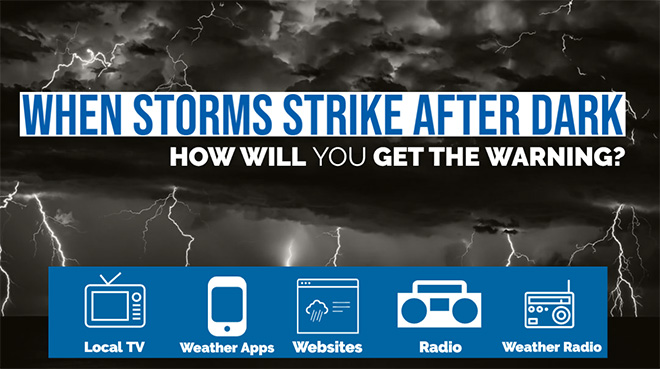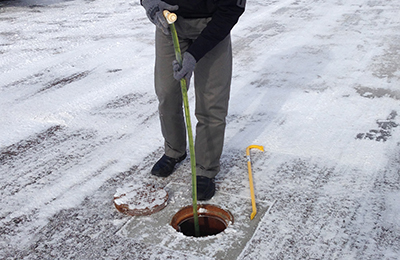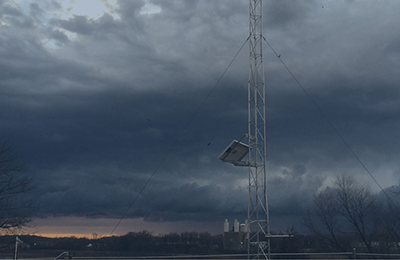Preparing for severe weather
 Severe weather season is almost here, which means it is time to refresh our severe weather safety knowledge.
Severe weather season is almost here, which means it is time to refresh our severe weather safety knowledge.
Climate change is causing weather to become more extreme. As severe weather events grow more frequent and impactful, it’s important to prepare.
How climate change is contributing to severe weather
The Earth’s surface temperature is increasing due to multiple factors: greenhouse gases, agriculture, road construction, and deforestation are just a few.
These factors allow the Earth to absorb more radiant energy from the Sun, and in turn warm the troposphere, the layer of the atmosphere where we live.
We are seeing more and worse floods due to extreme weather and higher precipitation. For example, a flood so severe used to happen once a century could now happen every decade. A flood that happened once a decade could now happen every year.
We will also likely see more thunderstorms with damaging winds, large hail, and more intense rainfall. With climate change increasing our average temperature, it is likely we will experience more frequent, severe, and long-lasting extreme heat events.
Actions you can take to prepare
This information comes from Hennepin County Emergency Management, National Weather Service, and Minnesota Homeland Security and Emergency Management.
Watch for weather alerts and warnings

- Severe weather watch – issued when severe weather is expected in a few hours
- Severe weather warning – severe weather is happening, and you need to act now
Stay alert: know your siren safety protocols
Outdoor warning sirens are activated when the National Weather Service issues a tornado warning or reports dangerous conditions, such as severe straight-line winds. These sirens are meant for people who are outside and may not have access to other forms of warning. If you hear a siren, it’s your signal to get to a safe place.
While sirens provide a warning for those who are outdoors, those inside may not hear them. Make sure you have other means of receiving warnings, such as NOAA weather radios, local television, or radio stations.
Siren safety tips
- Be weather aware: Check forecasts in the morning and stay informed throughout the day, especially when severe weather is predicted.
- Take immediate action: When you hear a siren, find a safe place and tune to local weather stations or your NOAA weather radio for further information.
- Know where to shelter: Learn and practice your emergency procedures at work and at school. Familiarize yourself with safe locations in your home and neighborhood.
- Get a personal warning: Indoor alerts are vital. Make sure you have a NOAA weather radio or download a severe weather phone application, such as the Red Cross Emergency app, on your smartphone to stay informed.
A hidden disaster survival tool: radio and tv
When power outages occur, especially during severe weather, don’t rely solely on smart devices. Having multiple ways to receive emergency alerts is crucial. Hennepin County highlights the importance of having broadcast radio and television as part of your disaster survival plan.
How to incorporate radio and tv into your disaster plan
- NOAA All-Hazards Weather Radios: Available for $20-$40, these radios provide real-time weather updates and warnings.
- Portable AM/FM radios: Keep one with extra batteries to ensure you have access to broadcasts during emergencies.
- TV broadcast antenna: If your cable or satellite service fails, a basic antenna can help you access broadcast TV and emergency alerts.
In the Twin Cities, TPT Now (broadcast channel 2.5) provides continuous public health and safety information in multiple languages, including English, Spanish, Hmong, and Somali, to ensure accessibility for all communities.
Avoid outdoors during severe weather, lightning, and hail
Every thunderstorm shares one common hazard: lightning. Lightning kills an average of 43 people each year with hundreds more severely injured. Make sure, when thunder roars, go indoors!
Be prepared for flash floods
 Flash flooding can happen suddenly, so it’s important to be prepared. Be prepared to evacuate and go to high ground. If you see a road flooded, turn around, don’t drown. If you cannot see the pavement under the water, you don’t know if it is still there. Water levels and speed can change quickly, so you are safest by staying indoors or find higher ground if shelter is not available.
Flash flooding can happen suddenly, so it’s important to be prepared. Be prepared to evacuate and go to high ground. If you see a road flooded, turn around, don’t drown. If you cannot see the pavement under the water, you don’t know if it is still there. Water levels and speed can change quickly, so you are safest by staying indoors or find higher ground if shelter is not available.
Know when to seek shelter from tornadoes
Although tornadoes are better forecasted and warnings provide longer lead times to seek shelter, it is important to know where those shelters are no matter where you are. Make sure you and your loved ones know where to seek shelter while at home, work, or at school.
Stay cool during extreme heat
 The spring, summer, and fall are beautiful times of the year, but can also bring warm temperatures.
The spring, summer, and fall are beautiful times of the year, but can also bring warm temperatures.
Make sure to use your air conditioning during hot weather or find a cooling option near you. For cooling options, visit hennepin.us/cool.
A few other ways to prevent heat illnesses is to slow down, dress for summer, limit your time in direct sunlight, stay hydrated, eat light, and take cool showers or baths to prevent yourself from getting heat exhaustion or heat stroke.
Real-time weather monitoring
Stay ahead of severe weather by checking interactive weather forecasts and maps available on Hennepin County’s weather monitoring site.
Receive email notifications to get information about monthly outdoor warning siren tests, growl and maintenance tests, or erroneous siren soundings. Sign up to receive Public Warning Systems emails.

